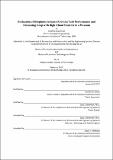Evaluation of sleepiness in space robotics task performance and discussing sleep with high school students in a museum
Author(s)
Lowenthal, Caroline (Caroline S.)
DownloadFull printable version (7.171Mb)
Other Contributors
Massachusetts Institute of Technology. Technology and Policy Program.
Advisor
Charles M. Oman.
Terms of use
Metadata
Show full item recordAbstract
Sleepiness impacts performance in all aspects of life. This thesis addresses the impact of sleepiness on astronauts and adolescents in their everyday tasks. The first part describes the results of an experiment assessing the effect of sleepiness and workload on performance in simulated space telerobotics tasks. The second part describes the results of a forum discussion with high school students about school start time based on information about adolescent sleep biology and various stakeholder perspectives. Astronauts must maintain a high level of performance during space robotics operations, despite sleep schedules that hinder their cognitive function, response time, and attention. This study aimed to determine the usefulness of secondary tasks to assess sleepiness and workload during simulated space robotics performance. 13 naive subjects were trained to perform two types of robotics tasks and two types of secondary tasks measuring response time. Subjects completed two 2-hour robotics sessions, one at midday after approximately 4 hours awake, and one at night after 18 hours awake. Comparing 18 hours awake versus 4, Karolinska Sleepiness Scale scores increased by at least 2 points. Subjects maintained primary robotics task performance at the night session, but secondary task measures such as inverse response time showed significant changes, with moderate Hedges' g (0.35 to 0.74) effect sizes. For a passive monitoring of arm movement primary task, a simple response secondary task metric proved more sensitive to time awake than a two choice response secondary task, but the converse was found when the primary task involved track and capture manual control. Our visual secondary task was sensitive to changes in primary task workload and sleepiness. Secondary task workload measures are a potentially useful adjunct to primary task drowsiness metrics like PVT and deserve further investigation. In Part II, we hypothesized that informed high school students can make strong recommendations about school start time after learning about the biology of their sleep needs and participating in a discussion forum to consider various stakeholder perspectives. 26 high school students from Fenway High School participated in a forum at the Museum of Science. Before the forum, they completed a survey about their sleep habits. During the forum, they participated in a role play exercise, taking on the roles of parent, sleep researcher, administrator, student, and teacher and negotiating tradeoffs about school start time. In the post-forum survey, students showed learning about sleep and made good recommendations to share with their peers. They value sleep and think that getting enough sleep is important, yet by their self-reported actions they seem to value other activities more.
Description
Thesis (S.M.)--Massachusetts Institute of Technology, Dept. of Aeronautics and Astronautics; and, (S.M. in Technology and Policy)--Massachusetts Institute of Technology, Engineering Systems Division, Technology and Policy Program, 2012. This electronic version was submitted by the student author. The certified thesis is available in the Institute Archives and Special Collections. Cataloged from student submitted PDF version of thesis. Includes bibliographical references (p. 47-50).
Date issued
2012Department
Massachusetts Institute of Technology. Department of Aeronautics and Astronautics; Massachusetts Institute of Technology. Engineering Systems Division; Technology and Policy ProgramPublisher
Massachusetts Institute of Technology
Keywords
Aeronautics and Astronautics., Engineering Systems Division., Technology and Policy Program.